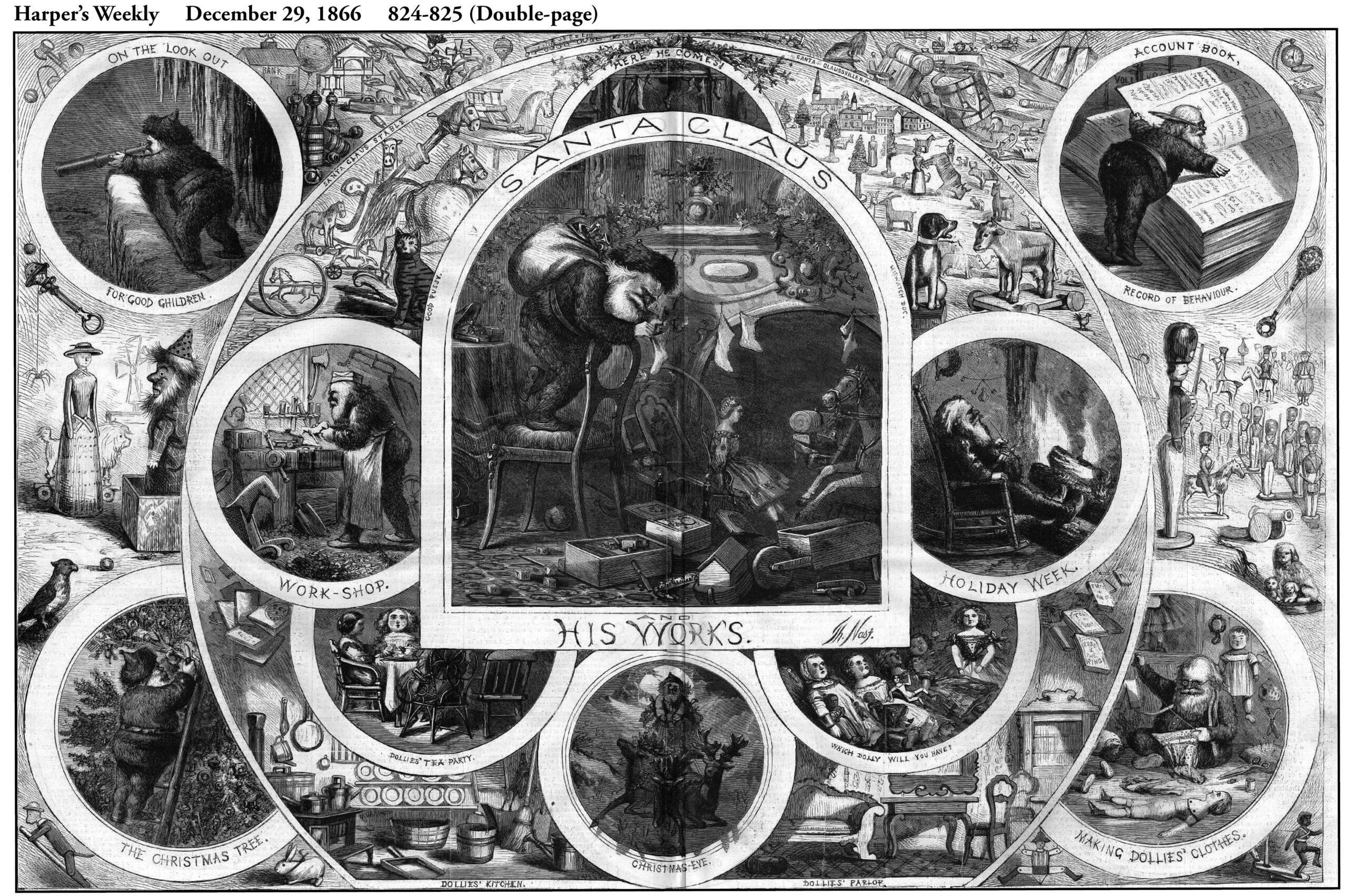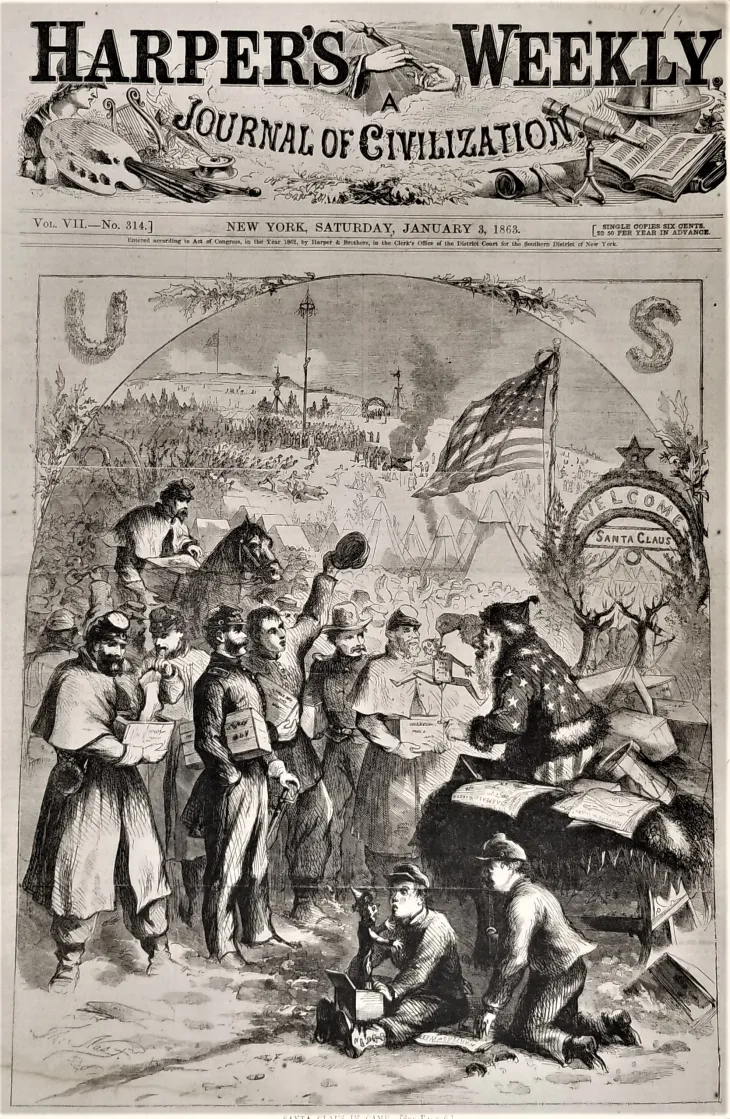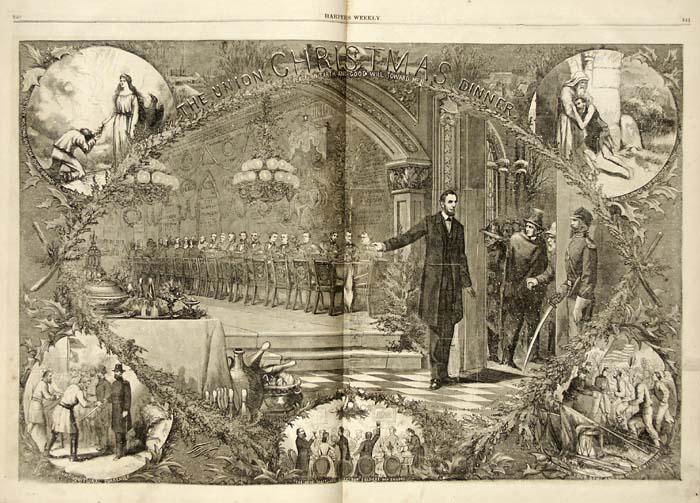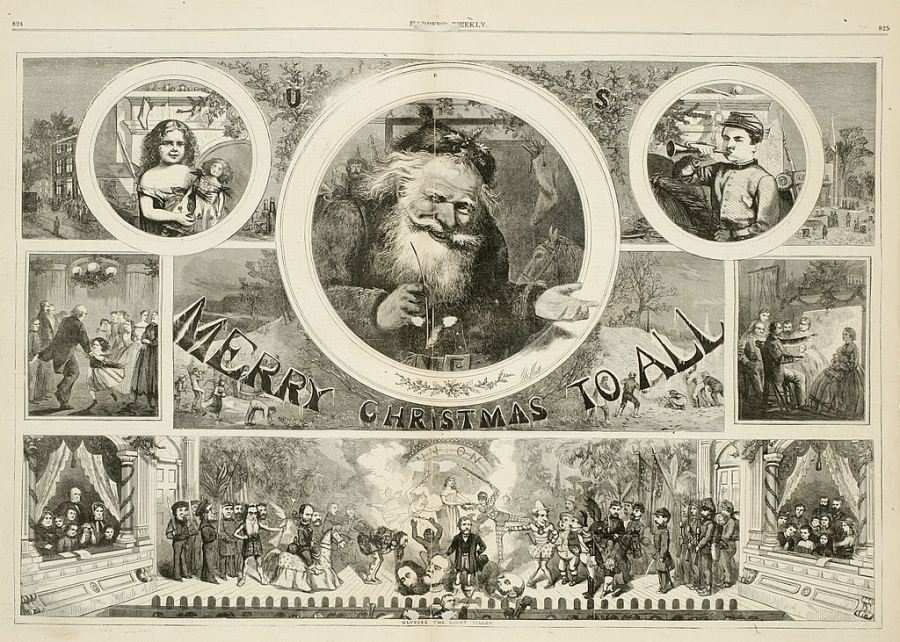How Civil War Cartoonist Thomas Nast Created Our Image of Santa Claus and Turned Santa into a Full-Fledged Union Supporter

Santa Claus may not be the image that first comes to mind when people think of the Civil War, but the image of Santa Claus as many people picture him today dates back to the Civil War when a man famous for his Civil War depictions first created that image: Thomas Nast.
In the above engraving from Christmas 1863, the central image portrays a soldier on furlough returning home from the war to celebrate Christmas with his family. He is surrounded by scenes we often associate with the holiday. At the top left, children are nestled in their beds while Santa, dressed in fur and sporting a long white beard, has just come down the chimney and is confirming that they are sleeping before secretly delivering toys from his large sack. In the morning, top right, the children wake excitedly to check their stockings and open their gifts. At the bottom left, a light shines on baby Jesus in a manger scene. Bottom middle, a family gathers around a well-lit table to eat their Christmas dinner. Finally, at the bottom right, people greet each other in their Christmas finery as they gather to attend church and celebrate Christ’s birth. The scenes capture the optimistic, more hopeful mood in the North in December 1863 following significant victories in Gettysburg, Vicksburg, and Chattanooga.
A year earlier, the mood in the North was far more dreary following the Union defeat at Fredericksburg and the high number of casualties at Shiloh, and the same couple – happily reunited in the 1863 illustration – is seen in very different circumstances. The woman kneels and prays beside her sleeping children, thinking of her husband, far away on the battlefield. He is seen leaning against a tree, solitary and rather forlorn, looking at photos and thinking of his family back home as he tries to warm himself by the fire. Scenes of the war are all around him, but above, Santa is still going about his business, delivering presents to children.
As described on The Met museum website: “This was the moment that Nast conceived and introduced our modern image of Santa Claus. Combining European traditions of St. Nicholas with folk images of elves from his native Germany, he created the jolly gift-giver now associated with Christmas. Above at left, Santa has landed on a rooftop and prepares to descend the chimney. At right he is pulled through an army camp in a sleigh and tosses gifts to grateful soldiers. Somber scenes below remind of a grimmer reality–an army marching through snow and a row of frozen graves that refers to the Union’s recent failure to take Fredericksburg, Virginia, and many subsequent deaths from exposure. At right, a foundering ship symbolizes the challenges endured by the nation and uncannily foreshadows the December 31 sinking of the U.S.S. Monitor, the first ironclad, in a storm off Cape Hatteras.” [1]

Nast, who has been called the “Father of the American cartoon” and the “Prince of Caricaturists” [2], was born in Bavaria, Germany, in 1840 and immigrated to New York with his mother and sister in 1846. His father joined them there later. To learn more about Nast’s background and his work “drawing the war,” read this 2012 ECW post by Meg Groeling. Suffice it here to say, President Abraham Lincoln once called Nast the Union’s “best recruiting sergeant” and said his cartoons “never failed to arouse enthusiasm and patriotism.” [3] Ulysses S. Grant said Nast “did as much as any one man to preserve the Union and bring the war to an end” [4], and his influence was so great that Theodore Roosevelt once called him “our best teacher.” [5]
Nast’s influence continues to be felt during the Christmas season. His illustrations of Santa Claus for the magazine Harper’s Weekly — 33 in total between the years of 1863 and 1886 – crafted the image of Santa we recognize today. In his drawings, Nast portrayed Santa “coming down chimneys, filling stockings, and watching over sleeping children…. With time, Nast’s Santa Claus became a rotund, jolly old elf dressed in a red fur-trimmed jacket with a broad belt, boots, and a cap – a Santa that fit the spirit of Clement Moore’s poem,” and whom he partially modeled after himself. [6]
Moore’s famous poem “A Visit from Saint Nicholas,” better known by its first line, “Twas the night before Christmas,” had already done much to establish a “picture” of St. Nicholas in many people’s minds. First published in 1823, Moore’s poem described Santa as a plump and “jolly old elf” who “dressed all in fur, from his head to his foot,” wore sooty clothes, carried a bundle of toys on his back, had twinkling eyes, merry dimples, rosy cheeks, a cherry nose, a droll mouth “drawn up like a bow,” a snow white beard, a pipe between his teeth, and “a broad face and a little round belly that shook when he laughed, like a bowlful of jelly.” [7]
Nast took those images and ran with them. His drawings solidified what we now “know” about Santa — including giving him an address in “Santa Clausville” in the North Pole. There in his workshop, with the help of his elves, Santa makes lots of toys, including dolls, tea party sets, toy soldiers, rocking horses, hobby horses, drums, balls, and jack-in-the-boxes. He is always “on the look out for good children,” and he keeps an “account book/record of behavior” so he knows who deserves toys on Christmas Eve. He also decorates Christmas trees – a practice that became more popular in the early 1860s, partly due to Nast’s illustrations.

When Nast created his images of Santa, he drew on his own native German tradition, where Saint Nicholas – a fourth century bishop known for his kindness and generosity – was celebrated on December 6, “Saint Nicholas Day,” with festivals and gift giving. Nast also utilized scenes from his hometown of Morristown, New Jersey, according to Ryan Hyman, a curator at the Macculloch Hall Historical Museum in Morristown, which holds a large collection of his work and hosts an annual Christmas showcase. “The outside pictures that show rooftops and church spires were all here in Morristown,” Hyman said. [8]
Nast’s first image of Santa was, in fact, largely propagandistic in nature and appeared on the cover of the January 3, 1863 edition of Harper’s Weekly. In it, Santa Claus is seen sitting on his reindeer-pulled sleigh, distributing gifts to Union troops. An American flag flies above him, and a star-topped sign nearby reads, “Welcome, Santa Claus.” The letters “U” and “S” appear in the top corners, and copies of Harper’s Weekly lie scattered about for the soldiers’ reading enjoyment.
And, “lest any reader question Santa’s allegiance in the Civil War, he wears a jacket patterned with stars and pants colored in stripes. In his hands, he holds a puppet toy with a rope around its neck, its features like those of Confederate president Jefferson Davis,” with “JEFF” emblazoned on his chest. [9] An accompanying text states, “Santa Claus is entertaining the soldiers by showing them Jeff Davis’s future. He is tying a cord pretty tightly round his neck, and Jeff Davis seems to be kicking very much at such a fate.” [10] Clearly, Nast’s Santa supported the Union – as did Harper’s Weekly.

The Union soldiers – looking both surprised and pleased – stand in line to receive their gifts, surrounded by a flurry of activity: “A soldier opens his Christmas box to find a fully loaded stocking, while a comrade behind him gets a meerschaum pipe. In the foreground, a sprung jack-in-the-box surprises two drummer boys. In the background, soldiers chase a greased pig while others climb a greased pole to reach a cash purse nailed to the top. Some play football; others prepare company Christmas dinners. The fort on the hilltop pays tribute to Santa’s arrival with an artillery salute.” [11]
“Christmas in Camp” appeared in the same issue as “Christmas Eve, 1862,” shown above. “In these two drawings, Christmas became a Union holiday and Santa a Union local deity — a positive spirit of Northern plenty and domesticity, to set alongside and against the Southern myth of chivalry and tradition and deep indigenous culture,” Adam Gopnik wrote in a 1997 issue of the New Yorker. It was the “Christmas Eve” image, though, that overnight “became the favorite Northern image of the war…. Despite its morbidity, it was a morale builder, for it gave Christmas to the North — gave to the Union cause an aura of domestic sentiment, and even sentimentality.” [12]
In December 1864, Nast skipped depicting Santa at Christmas and instead portrayed President Abraham Lincoln inviting Confederate generals to “The Union Christmas Dinner.” This cartoon primarily presented a political message: “The obvious focal theme was President Lincoln welcoming Jeff Davis, Robert E. Lee and their associates to the Union Banquet Hall. The Northern governors — all recognizable — were seated at a long table opposite a row of empty chairs, each reserved for a specific Confederate state. An olive branch at the upper left and the return of the prodigal son at the upper right completed the allegorical imagery. If the Confederacy would lay down its arms, surrender unconditionally and be contrite, the Union — with Lincoln as its dominant forgiving father — would welcome Rebeldom back into the fold. The prophetic vignette at the lower left anticipated Lee’s surrender to Ulysses Grant at Appomattox by exactly 100 days. William Sherman was on Grant’s right with George Meade, who won at Gettysburg and was Grant’s second-in-command in Virginia, next to him. George Thomas appeared for the first time in a Nast cartoon, receiving John Bell Hood’s sword.” [13]

The inset at the bottom right, captioned “Lay Down your Arms and You Will be Welcome,” shows Rebel soldiers being welcomed back into the Union. At the top left, a soldier bows down to accept a pardon from Lady Liberty. The image captures the rising hope that soon, the country might be united once again.
In 1865, Nast returned to his Christmas-time portrayal of Santa with his “Merry Christmas to All” image. However, despite the war’s finally being at a close, he incorporates a strong political jab. Amidst the scenes of celebration – Santa with his pipe, a young girl with her doll, a boy with his bugle, lively dancing, and a family gathered around the hearth – he depicts “Ulysses the Giant Slayer,” with the heads of several Confederate generals at his feet. This image must have been a bit shocking to his audience. A poem in that same edition, however, titled “By the Christmas Hearth,” was much more conciliatory in its tone and celebrated the county’s reunification. In the final stanza, it lauds how “sweet it seems at home once more / to sit with those we hold most dear,” capturing the festive mood of the nation, all thankful to put the war behind them. [14]

Nast’s images of Santa are now deeply rooted in our national psyche. He, as well as other illustrators such as Winslow Homer, helped to popularize holiday traditions such as decorating Christmas trees, giving gifts, singing carols, enjoying holiday feasts, and sending Christmas cards. They also promoted the practice of sending soldiers Christmas boxes filled with homemade clothes and food items, and these boxes “gave their recipients a much-needed mental and physical boost.” [15]
Another Civil War correspondent, many years later, added his own mark to Christmas. Francis Pharcellus Church reported on the Civil War for both the New York Times and The Army and Navy Journal, then served as an editor and publisher of the Journal until 1874. On September 21, 1897, Church wrote an editorial in the New York Sun, in which he responded to eight-year-old Virginia O’Hanlon’s perplexing question as to whether there truly was a Santa Claus. His response (shown here in part) has gone down as one of the most famous editorials in American history:
“Yes, Virginia, there is a Santa Claus. He exists as certainly as love and generosity and devotion exist, and you know that they abound and give to your life its highest beauty and joy. Alas! How dreary would be the world if there were no Santa Claus. It would be as dreary as if there were no Virginias. There would be no childlike faith then, no poetry, no romance to make tolerable this existence. We should have no enjoyment, except in sense and sight. The eternal light with which childhood fills the world would be extinguished…. No Santa Claus! Thank God! he lives, and he lives forever. A thousand years from now, Virginia, nay, ten times ten thousand years from now, he will continue to make glad the heart of childhood.” [16]
Merry Christmas, everyone!
Endnotes:
- Nast, Thomas. “Thomas Nast | Christmas Eve (published “Harper’s Weekly,” January 3, 1863).” The Metropolitan Museum of Art, https://www.metmuseum.org/art/collection/search/427526.
- “Thomas Nast: Prince of Caricaturists | Digital Exhibits.” Ohio State University Libraries, https://library.osu.edu/site/thomasnast/.
- Lehrman, Lewis E. “» Mr. Lincoln and New York.” AbrahamLincoln.org, https://abrahamlincoln.org/features/essays/mr-lincoln-and-new-york/.
- Boissoneault, Lorraine. “A Civil War Cartoonist Created the Modern Image of Santa Claus as Union Propaganda.” Smithsonian Magazine, 19 December 2018, https://www.smithsonianmag.com/history/civil-war-cartoonist-created-modern-image-santa-claus-union-propaganda-180971074/.
- Nast, Thomas. “Thomas Nast.” Wikipedia, https://en.wikipedia.org/wiki/Thomas_Nast.
- Bennett, William J. The True Saint Nicholas: Why He Matters to Christmas. Howard Books, 2009, pg. 103.
- Moore, Clement C. “The Poem.” Twas The Night Before Christmas, https://www.twasthenightbeforechristmas.com/the-poem/.
- Boissoneault, Lorraine. “A Civil War Cartoonist Created the Modern Image of Santa Claus as Union Propaganda.” Smithsonian Magazine, 19 December 2018, https://www.smithsonianmag.com/history/civil-war-cartoonist-created-modern-image-santa-claus-union-propaganda-180971074/.
- Ibid.
- Lively, Mathew W. “Thomas Nast and Santa Claus in the Civil War.” Civil War Profiles, https://www.civilwarprofiles.com/thomas-nast-and-santa-claus-in-the-civil-war/.
- Rawlings, Kevin. “CHRISTMAS IN THE CIVIL WAR – December 1998 Civil War Times Feature.” HistoryNet, 23 September 1998, https://www.historynet.com/christmas-in-the-civil-war-december-1998-civil-war-times-feature/.
- Gopnik, Adam. “The Man Who Invented Santa Claus.” The New Yorker, 8 Dec 1997, pg. 84.
- “The Union Christmas Dinner | Cartoons.” Thomas Nast, 16 November 2022, https://thomasnast.com/cartoons/the-union-christmas-dinner-2/.
- Rawlings, Kevin. “CHRISTMAS IN THE CIVIL WAR – December 1998 Civil War Times Feature.” HistoryNet, 23 September 1998, https://www.historynet.com/christmas-in-the-civil-war-december-1998-civil-war-times-feature/.
- Ibid.
- Bever, Lindsey. “Is Santa real? Virginia O’Hanlon’s 1897 letter and the famous ‘Yes, Virginia’ editorial it inspired.” The Washington Post, 22 December 2018, https://www.washingtonpost.com/history/2018/12/22/is-there-santa-claus-how-childs-letter-inspired-classic-yes-virginia-response/.
1 Response to How Civil War Cartoonist Thomas Nast Created Our Image of Santa Claus and Turned Santa into a Full-Fledged Union Supporter